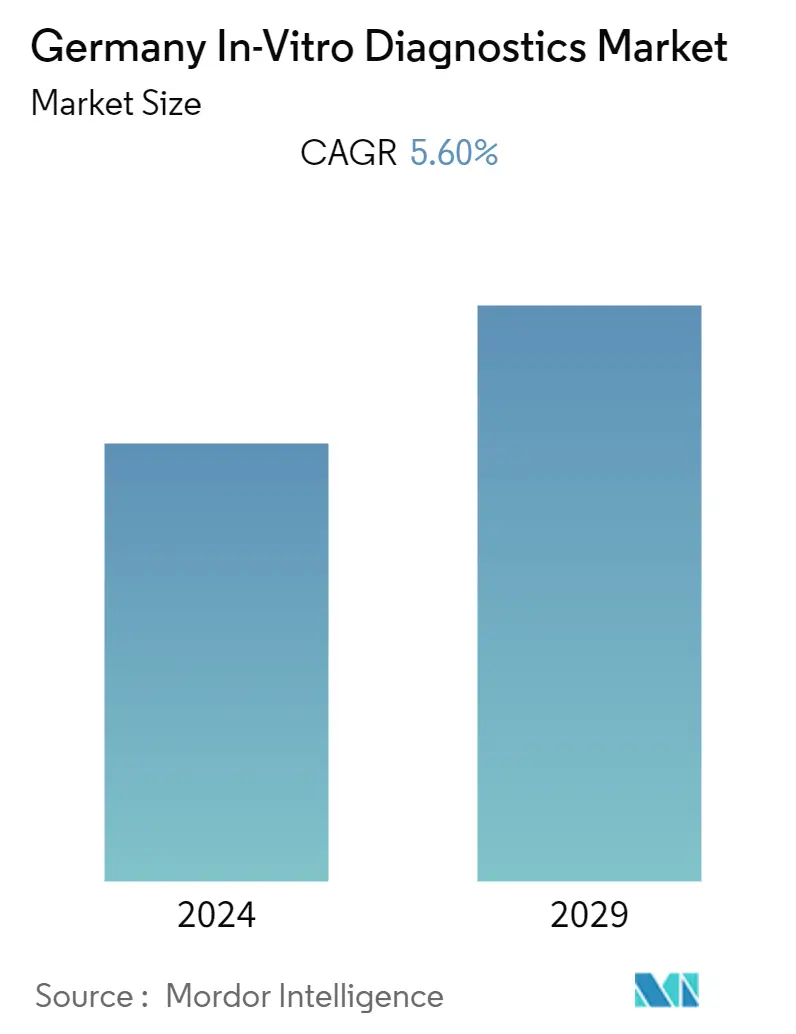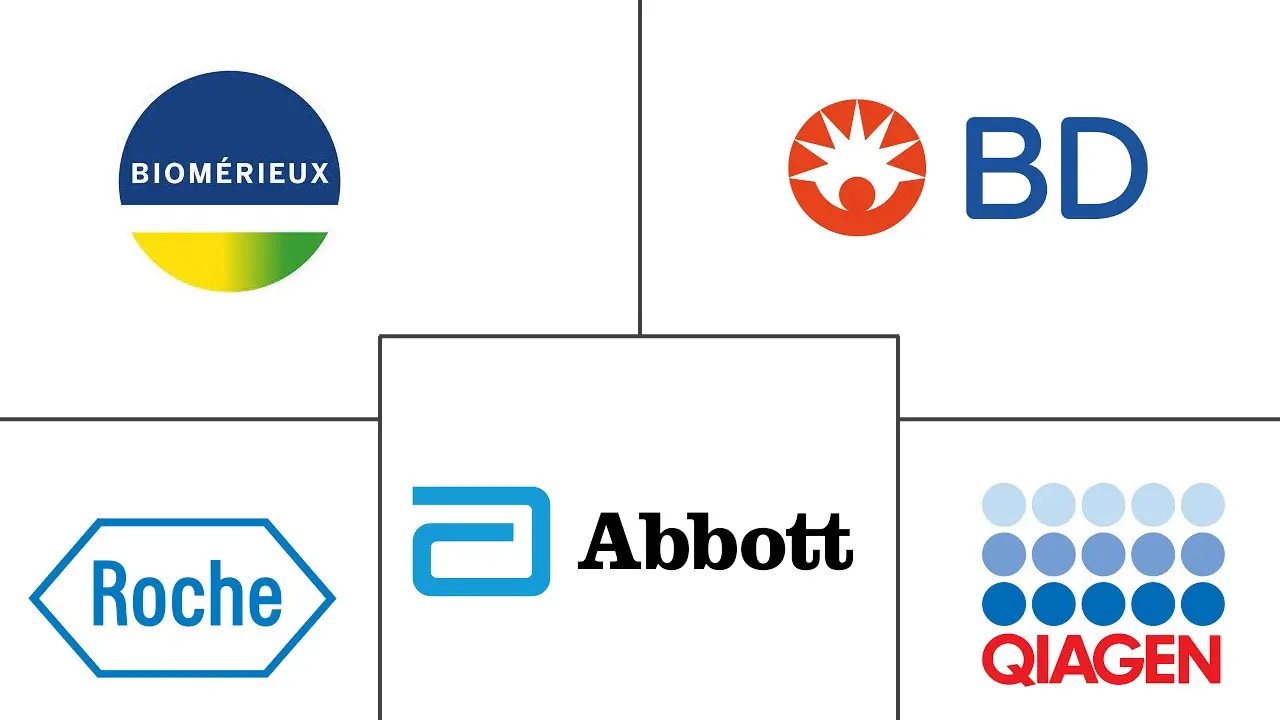Market Size of Germany In-Vitro Diagnostics Industry

| Study Period | 2019 - 2029 |
| Base Year For Estimation | 2023 |
| Forecast Data Period | 2024 - 2029 |
| Historical Data Period | 2019 - 2022 |
| CAGR | 5.60 % |
Major Players
*Disclaimer: Major Players sorted in no particular order |
Germany In-Vitro Diagnostics (IVD) Market Analysis
The Germany in-vitro diagnostics market is expected to register a CAGR of 5.6% over the forecast period.
- COVID-19 pandemic increased the demand for in-vitro diagnostic products in Germany due to the sharp rise in demand for polymerase chain reaction (PCR), next-generation sequencing (NGS), serology-based rapid-test products, the supportive regulatory landscape for product development and commercialization, and a rapid rise in target patient population which has boosted the market growth. Furthermore, rising initiatives from the key market players to distribute COVID-19 IVD tests propelled the market growth during the pandemic. For instance, in March 2020, Bruker Corporation entered a distribution agreement with Primer Design Ltd to distribute the CE-IVD-labeled genesig real-time PCR coronavirus (COVID-2019) assay in Germany. Thus, the rising tests and novel product launches boosted the market's growth during the pandemic. Therefore, the market slightly declined during the early pandemic due to supply chain restrictions and stringent lockdowns. However, the market gained a significant pace post-pandemic and is expected to show significant growth during the forecast period.
- The rising prevalence of chronic diseases, the increasing aging population, the surge in demand for accurate diagnosis, and favorable government initiatives are the key driving factors for the growth of the in-vitro diagnostics market in Germany. For instance, according to the study published in Experimental and Therapeutic Medicine in August 2021, the estimated incidence of ovarian cancer in Germany was reported to have a rate of 10.2 per 100,000. In addition, as per the 2021 report of the International Diabetes Federation (IDF), there were about 6.2 million people in Germany with diabetes. This number is projected to reach 6.5 million by 2030. Therefore, the rising incidence of chronic diseases such as cancers and diabetes is expected to drive the market study due to the increased adoption of in-vitro diagnostics for early detection.
- Furthermore, rising initiatives from the key market players are expected to propel the market growth over the forecast period. For instance, in May 2021, QIAGEN N.V. collaborated with Mirati Therapeutics Inc. to continue developing a tissue-based KRAS companion diagnostic to identify patients with cancers that have a KRASG12C mutation. The planned companion diagnostic would expand upon QIAGEN's therascreen KRAS testing portfolio based on real-time qualitative PCR for the QIAGEN Rotor-Gene Q MDx instrument, thereby increasing the adoption of QIAGEN Q MDx instrument, driving the market growth.
- Therefore, the rising incidence of chronic disease and the rising initiatives such as partnerships from the key market players are the factors expected to drive the market growth over the forecast period. However, stringent regulations coupled with cumbersome reimbursement procedures are a factor expected to hamper the market growth.
Germany In-Vitro Diagnostics (IVD) Industry Segmentation
As per the scope of this report, the in-vitro diagnostics market includes medical devices and consumables that are utilized to perform in vitro tests on various biological samples. They are used to diagnose various medical conditions, such as diabetes, cancer, and other diseases.
The German in-vitro diagnostics market is segmented by test type (clinical chemistry, molecular diagnostics, immunodiagnostics, hematology, and other test types), product (instruments, reagents, and other products), usability (disposable IVD devices and reusable IVD devices), application (infectious disease, diabetes, cancer/oncology, cardiology, autoimmune disease, nephrology, and other applications), and end-user (diagnostic laboratories, hospitals and clinics, and other end-users).
The report offers the value (in USD) for the above segments.
| By Test Type | |
| Clinical Chemistry | |
| Molecular Diagnostics | |
| Immuno Diagnostics | |
| Hematology | |
| Other Test Types |
| By Product | |
| Instruments | |
| Reagents | |
| Other Products |
| By Usability | |
| Disposable IVD Devices | |
| Reusable IVD Devices |
| By Application | |
| Infectious Disease | |
| Diabetes | |
| Cancer/Oncology | |
| Cardiology | |
| Autoimmune Disease | |
| Nephrology | |
| Other Applications |
| By End-Users | |
| Diagnostic Laboratories | |
| Hospitals and Clinics | |
| Other End-Users |
Germany In-Vitro Diagnostics Market Size Summary
The Germany in-vitro diagnostics market is poised for significant growth, driven by the increasing prevalence of chronic diseases and an aging population. The demand for accurate diagnostic tools is on the rise, supported by favorable government initiatives and advancements in molecular diagnostics. The market experienced a surge in demand during the COVID-19 pandemic, with a notable increase in the use of polymerase chain reaction (PCR) and next-generation sequencing (NGS) technologies. This was further bolstered by strategic partnerships and product launches by key market players, which have continued to shape the competitive landscape. Despite initial setbacks due to supply chain disruptions, the market has rebounded and is expected to maintain a steady growth trajectory over the forecast period.
The market is characterized by a fragmented landscape with numerous players engaging in strategic initiatives such as product development, collaborations, and acquisitions to strengthen their market positions. The high burden of cancer and other chronic diseases has led to increased adoption of in-vitro diagnostics for early detection and treatment. Key players like Qiagen N.V., Siemens Healthcare GmbH, and others are actively involved in expanding their product offerings and enhancing their technological capabilities. Initiatives such as the distribution of advanced diagnostic tools and participation in government programs have further propelled market growth. However, challenges such as stringent regulations and complex reimbursement processes continue to pose hurdles to market expansion.
Germany In-Vitro Diagnostics Market Size - Table of Contents
-
1. MARKET DYNAMICS
-
1.1 Market Overview
-
1.2 Market Drivers
-
1.2.1 Rapid Increase in Chronic Diseases Coupled with Increasing Demand for Point-of-Care Testing and Personalized Medicine
-
1.2.2 Increasing Number of Private Hospitals and Independent Testing Laboratories
-
-
1.3 Market Restraints
-
1.3.1 Stringent Regulations Coupled with Cumbersome Reimbursement Procedures
-
-
1.4 Porter's Five Forces Analysis
-
1.4.1 Threat of New Entrants
-
1.4.2 Bargaining Power of Buyers/Consumers
-
1.4.3 Bargaining Power of Suppliers
-
1.4.4 Threat of Substitute Products
-
1.4.5 Intensity of Competitive Rivalry
-
-
-
2. MARKET SEGMENTATION (Market Size by Value- USD)
-
2.1 By Test Type
-
2.1.1 Clinical Chemistry
-
2.1.2 Molecular Diagnostics
-
2.1.3 Immuno Diagnostics
-
2.1.4 Hematology
-
2.1.5 Other Test Types
-
-
2.2 By Product
-
2.2.1 Instruments
-
2.2.2 Reagents
-
2.2.3 Other Products
-
-
2.3 By Usability
-
2.3.1 Disposable IVD Devices
-
2.3.2 Reusable IVD Devices
-
-
2.4 By Application
-
2.4.1 Infectious Disease
-
2.4.2 Diabetes
-
2.4.3 Cancer/Oncology
-
2.4.4 Cardiology
-
2.4.5 Autoimmune Disease
-
2.4.6 Nephrology
-
2.4.7 Other Applications
-
-
2.5 By End-Users
-
2.5.1 Diagnostic Laboratories
-
2.5.2 Hospitals and Clinics
-
2.5.3 Other End-Users
-
-
Germany In-Vitro Diagnostics Market Size FAQs
What is the current Germany In-Vitro Diagnostics Market size?
The Germany In-Vitro Diagnostics Market is projected to register a CAGR of 5.60% during the forecast period (2024-2029)
Who are the key players in Germany In-Vitro Diagnostics Market?
Qiagen N.V., Siemens Healthcare GmbH, Epigenomics Inc., Abbott Laboratories and F. Hoffmann-La Roche Ltd are the major companies operating in the Germany In-Vitro Diagnostics Market.

